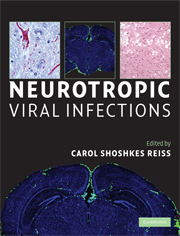Book contents
- Frontmatter
- Contents
- List of contributors
- Foreword
- Preface and acknowledgments
- Section I Introduction: RNA viruses
- 1 Neurotropic picornaviruses
- 2 Subacute sclerosing panencephalitis
- 3 Rabies
- 4 Neurotropic coronavirus infections
- 5 Arenavirus infection in the nervous system: uncovering principles of virus–host interaction and viral pathogenesis
- 6 Neurotropic alphaviruses
- 7 Flaviviruses
- Section II Introduction: retroviruses, DNA viruses, and prions
- Section III Introduction: immunity, diagnosis, vector, and beneficial uses of neurotropic viruses
- Index
- Plate section
- References
3 - Rabies
from Section I - Introduction: RNA viruses
Published online by Cambridge University Press: 22 August 2009
- Frontmatter
- Contents
- List of contributors
- Foreword
- Preface and acknowledgments
- Section I Introduction: RNA viruses
- 1 Neurotropic picornaviruses
- 2 Subacute sclerosing panencephalitis
- 3 Rabies
- 4 Neurotropic coronavirus infections
- 5 Arenavirus infection in the nervous system: uncovering principles of virus–host interaction and viral pathogenesis
- 6 Neurotropic alphaviruses
- 7 Flaviviruses
- Section II Introduction: retroviruses, DNA viruses, and prions
- Section III Introduction: immunity, diagnosis, vector, and beneficial uses of neurotropic viruses
- Index
- Plate section
- References
Summary
Introduction
Rabies virus is a pathogen well-adapted to the mammalian nervous system, where it infects the neurons. It causes rabies, an acute myeloencephalitis that is fatal in most mammalian species and humans in particular. Rabies virus is transmitted by saliva of an infected animal through bites or scratches or by unfortunate transplantation of organs from unsuspected rabid donors. Rabies virus enters the nervous system via a motor neuron through the neuromuscular junction or via a sensory nerve through nerve spindles. It then travels from one neuron to the next along the spinal cord to the brain. It causes behavior changes such as a furious state in dogs, loss of natural shyness in wild animals, or spectacular hydrophobia in humans. After brain invasion, the virus reaches the salivary glands where virions are excreted in the saliva. In the meantime, virus spreads to several peripheral organs of digestive, pulmonary, and urinary systems. Once the virus enters the central nervous system, no therapeutic treatment can battle the infection, and rabies is almost invariably fatal. Successful invasion of the nervous system by rabies virus seems to be the result of a subversive strategy based on the survival of infected neurons. However, rabies can be prevented by prompt post-exposure treatment with injection of killed rabies vaccine along with rabies-specific immunoglobulins. Postexposure treatment of rabies requires public information, access to medical facilities, and availability of efficient postexposure rabies vaccine, which are lacking in most parts of the world.
- Type
- Chapter
- Information
- Neurotropic Viral Infections , pp. 35 - 49Publisher: Cambridge University PressPrint publication year: 2008
References
- 1
- Cited by

